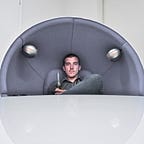How to get started in VR as a designer
--
A friend recently asked me how to get started in VR. It’s a great question because (as I wrote in December) the future is not a screen you can touch, and any designer who wants to remain relevant to the next decade of computing needs to update their skills post haste.
Update: If you read one article on design principles, make it this one:
https://uxdesign.cc/design-practices-in-virtual-reality-f900f5935826#.7fkb0dupu
Sketching / Prototyping
I didn’t want to bore my friend with a long answer, so here it is in point form for everybody:
- Step 1: Get cardboard and THE BEST smartphone you can (ie. at least an iPhone 6 / 6s). You want to do all you can to avoid performance bottlenecks. You want to focus on design, not optimization.
- Step 2: Learn Aframe.io to prototype. Also, FramerJS has some VR components you might want to muck with. These will let you do relatively simple blocking and interactions with relatively little fuss.
- Step 3: Reach limits of Aframe and drill down a layer to learn ThreeJS to prototype. At some point, you will require a level of customization that nobody has written an Aframe component for yet. This is a good sign that you are pushing things forward.
- Step 4: Reach limits of cardboard interactions (one single button + gaze) and the web, and move on to Unity/Unreal + GearVR (which means you must toss your iPhone aside and submit your wallet to Samsung … I didn’t say this would be cheap.) Arguably, this is Step 4a (reach limits of the web) and step 4b (reach limits of cardboard). Entry level hardware and entry level software. You’ll probably hit the limits of both around the same time.
- Step 5: Reach limits of GearVR interactions (basically a d-pad and gaze) and move on to Rift / PSVR / Vive.
Update: Worth noting that both Unity and Unreal have plans to release VR world editors that don’t require coding knowledge, but do require you to have a desktop VR system and don’t yet fully address scripting behaviours.
If you make it to step 5, starting from step 1, this list is probably already out of date. Heck, if you know who the 2016 presidential candidates are, this list is probably already out of date.
So many ways to skin this future cat.
Ultimately, there is no meaningful way to do VR design right now without some “code” as far as I’m aware. Sorry, not sorry. I’m certain this will change quickly, though. Somebody will surely make design tools on room scale platforms like the Vive.
“Where is the reading list?” you might ask. Well, that changes way quicker than the tools, so pursue at your own speed & peril on your usual internet channels. It’s 2016 and the world is a high-performance library. I do highly recommend the Voices of VR podcast for casually keeping up to date on the space, though.
Please holler at me if there’s some better advice than what I’ve given.
Like I said, so many ways to skin this future cat.
